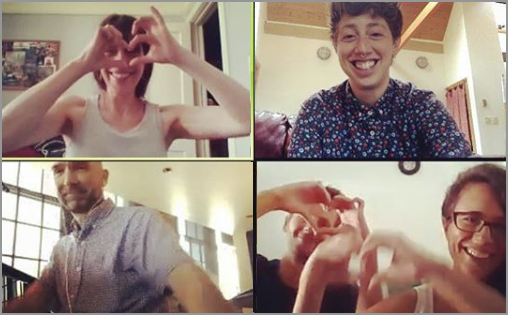When you land on a new idea or discover a fun subject to explore, it feels so exciting! Maybe you want to share your new thing with the world as quickly as possible. Maybe you almost feel like you’ll burst. Many multipotentialites frequently feel this way, but sharing your ideas with others too soon can sometimes lead to disillusionment. If your pals or loved ones aren’t as pumped as you are right out of the gate, it can be deflating.
It doesn’t have to be that way. You can keep that gung-ho feeling going much longer if you create a secret space to ruminate and develop before letting anyone weigh in.
You need Skunk Works.
History of a super-secret lab
Contrary to how it sounds, Skunk Works is not a place where a black and white-striped mammal concocts new scents. It’s actually a holdover from the last century.
In the 1930s, aircraft manufacturer Lockheed Martin was developing new systems and equipment for the U.S. military. While they had a team of engineers coming up with lots of new ideas, military leaders weren’t always confident in their most outside-the-box concepts. New developments got squashed before they were fully realized. Progress could be stifled by a Senator with a pessimistic budget outlook or a General with no clear understanding of the developing technology.
After much frustration, the company created a secret lab for what they termed Advanced Development Projects. Their engineers had their own pseudonym for the lab: Skunk Works.
Skunk Works was a super-secret lab where engineers could develop new systems to their hearts’ content. No authority could weigh in and halt progress. The only factor in whether or not a new project would move forward was the opinion of the engineers themselves.
Only after a new concept had been fully developed, tested, and proven would it be presented to the military or to Congress. Imagine how much was accomplished without the engineers looking over their shoulders, worried that their project would get the ax before it was ready.
The Skunk Works lab was so successful that the term “skunkworks” is widely used in business, engineering, and technical fields today. Now, you can appropriate the concept for your own use.
Some of the best ideas flourish in privacy
Creating a super-secret lab of your very own is relatively easy, and it doesn’t have to cost you a dime.
The best part is that you don’t necessarily need a physical space to do your work. You don’t need a separate room, a disused garage, or to have a child leave the nest in order to open your secret lab. It can be a Moleskine notebook if you want. Your secret lab could even be all inside your head.
Of course, you can call your lab whatever you want. After all, “skunkworks” doesn’t sound like a very aromatically pleasing place to work. And, unlike Lockheed Martin, you don’t need to use your lab to develop supersonic fighter jets—or misuse U.S. taxpayer money to illegally lobby for government contracts. Your lab can be an ethically sound center for the discovery of new plant species, or a home for tinkering with vintage film cameras. It can be centered around anything you want, with multiple departments for varying areas of experimentation.
The greatest thing about your secret lab is that it’s private. There will be no authority overseeing your projects, except you. You’ll have free rein to develop whatever your mind can imagine, and to stop and start projects on your own terms.
My grandmother had her own secret lab dedicated to sewing projects. It was piled with fabric, sewing machines, yarn, crafts—a little bit of everything. Trying to navigate that space or make sense of anything was nigh impossible for anyone but Grandma. And that’s fine. Her lab was her domain, impervious to the judgment of anyone else.
My personal skunkworks is a bookshelf in my office. It’s filled with old laptops, monitors, a Raspberry Pi, circuit boards, and various electronic parts. It’s a special place where I get to tinker with new and old tech, without worrying whether or not my latest project makes sense to anyone else. So far I’ve been able to give a 15-year old MacBook a new life as a Linux machine, and I created a media server for our home using an old laptop and other components. I have other projects in the works, but I’m not divulging them until I have a better handle on where they’re headed.
Keeping your projects to yourself might give them a higher chance of success
The most important part of creating a secret lab is that, in so doing, you are officially sealing the doors on your ideas to prying eyes (or ears). The only people you’ll invite inside are the ones who might help you build your new thing—and, then, only if necessary. We all need a place to kick around ideas or work on things that may never come to fruition. Knowing they won’t be examined (or even known about) by anyone outside the lab really takes the pressure off!
A secret space to work on new things helps to keep you from quelling your own interest early on, when you’re still figuring things out. There’s no judgment allowed in the lab, only wild experimentation and idea generation. You could ruminate on an idea for weeks, do some research, and ultimately decide that it’s just not that interesting to you after all. No one will be the wiser.
There’s no reason to explain to your friends or family why you’re suddenly dumping a newish idea. You’re the only authority in your lab. You also don’t have to give a presentation to a committee on why a certain project is taking so long to develop.
Multipotentialites will thrive on the freedom of developing new ideas in a secret space.
The next steps
Once something gets developed and tested a bit, you can choose to share it outside your lab. Show that handmade jewelry to a few friends, play your mom your latest composition, or hit publish on your brand new theory of everything. You might find that you feel more confident answering questions about your idea or project when you’ve had time to figure it out for yourself. You’ll be standing on firmer ground than you would be if you’d extemporaneously burst forth on a notion that needed more time to grow. Your potential for success is higher when you have time to test things out before you alert the six o’clock news.
Build yourself a secret lab—whether it’s in your head, a disused closet, or the back bedroom. The details aren’t that important. Give yourself a gift: the freedom to experiment in the confines of a private space, on your own time.
Your turn
Do you have any projects that your friends and family don’t know about? What would your ideal super-secret lab be like?

Doing/being/exploring ALL THE THINGS is easier with a community!

Did you know we have a private community of hundreds of multipotentialites from around the world? We support each other, share advice and cheer each other on as we building lives and career around ALL our passions.
Learn more about the Puttyverse and get notified next time we open the doors:


It’s like you’re inside my head. I LOVE this article and, yes, I do have a secret lab literally inside my closet. In addition to my product-based business and an occasional freelance illustration project, I decided to explore the field of voiceover work several months ago. I set up my “blanket booth” inside the closet in my office and I’ve been researching and practicing for about 6 months. I just started working with a voiceover coach and I’m loving it! I haven’t told one single person about this new interest, including my husband – who is busy with his own projects. I love the freedom to explore this new field, make mistakes and experiment, without any need to explain or justify my interest. If asked, I would happily tell my husband, but I don’t plan to until I actually get paid for a voiceover job. Thanks for the encouragement and validation – happy to know I’m not alone in loving my secret lab.
That’s amazing, Joan! I swear I won’t tell anyone. ;P
If it helps you to know, I have a friend who started out in his closet with a blanket doing voiceovers. He now has an agent and a thriving business doing what he loves for companies all over the world. You can do it, too.
My question is how do you give yourself permission to create in these spaces? There may not be anyone over my shoulder but I’M over my shoulder telling myself something is useless. I feel I struggle to play and experiment.
I totally get that, Alex. Sometimes I’m the only one telling me that something is useless, too.
Neil Hughes wrote about something very similar in his article, A Case For Trying Less Hard. https://puttylike.com/a-case-for-trying-less-hard/
I hope it’s helpful!
I have had my own “Skunk Lab” (I like that term) ever since I was a kid. My family vetoed everything I did except the projects and paths they chose for me. Now I hear only one comment, “You never talk about what you’re doing”. Yes, I do, when it is completed.
Ha! That’s perfect. I love it, Lynde!
I have kept a blog since 2008. Only a few people know about it, certainly not anyone within my immediate sphere. I am totally free in my blog to explore ideas that would get me shunned were I to voice them out loud–well, maybe not shunned, but misunderstood, and criticized. I love these ideas.
That’s a great idea, Marie. I may try that myself.
Thanks D. J., your blog was was really helpful. I often feel the need to tell people about my projects – to try and give myself some accountability to encourage myself to follow through – but then end up feeling bad when I don’t. Whereas a better approach might be to keep quiet about what I’m working on. So my lab would be not so much a physical space, but more a better way of working – which could end up being more flexible and creative and less pressured.
That’s exactly it, Kathy. I still have a hard time keeping my lips sealed about my projects. I have a habit of sharing my concepts way too early, which is partly what prompted this article. 🙂
You bring up an interesting point about accountability. It’s a great question, and I think Alex touched on that as well in an earlier comment. Is it possible to work with an accountability partner while keeping your project under wraps?
Hi D.J., Yes! I was thinking after I replied about how to bring in elements of accountability without the pressure. That’s a really good idea actually and it has worked well for circles of writers in the past. I’ll have a think about who that could be for me. It’s definitely worth a try – it just might take some experimentation to get the balance right.
Love the concept! And it is so easy!
When I decided to go back to university for my MBA I shared this with my family & friends. But what I didn’t tell them was that to do so I wanted to go far away to Asia. I just knew they would support the first part (where I needed some advice) but would hold me back from the second. So I only let them know my plans once the first applications were out. That was one of the best decisions of my life!
For me, being generally a person that rarely talks about my project, the key question is how to notice when I should talk about them (eg. to gain a new perspective). What are your thoughts on that?
That’s brilliant, Victoria! Your MBA “secret” is such a perfect example of this idea.
Your question is a great one, and it seems like a lot of people are wondering about that. I don’t think there can be one answer as to when to share. Every project/pursuit and person are different.
Your example of holding off on revealing that your MBA program was in Asia is a good one, because you had a clearly defined moment where you chose to reveal it. That’s not always the case, but it does make it easier to know.
Generally, I try to notice how confident I feel in what I’m doing. If I’m still feeling my way around and not sure I’ll even keep going, it may not be time to share. However, if I’m feeling sure of where I’m headed and won’t be easily put off by others’ doubts or non-understanding, then I will go ahead and share.
That said, I’ve *not* been able to keep a lid on my secret more than once. When you’re super excited, it can be hard to “keep the door shut” so to speak. 🙂